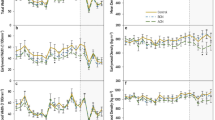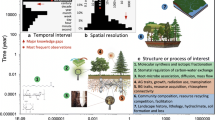Summary
Tree canopy water use and foliage net CO2 uptake (NPP) were simulated for a 31-year-old Pinus sylvestris (Scots pine) plantation near Hartheim, in the Upper Rhine Valley, Germany with a mechanistically-based, three-dimensional stand gas-exchange model (STANDFLUX) for a ten-day period during spring 1992. STANDFLUX was formulated to include the effects of penumbra caused by the fine structure of the needles on light distribution within crowns. Good correspondence was found between simulated rates of tree canopy water use when including penumbral effects and eddy-covariance ET and sap flow transpiration measurements. Water use was 8–13% lower and NPP was 10–17% lower in simulations for the ten-day period when penumbral effects were not included.
Simulated water use and CO2 uptake were compared with similar outputs from a simplified layer canopy model (including or not including penumbra) which assumed horizontal homogeneity in canopy structure (GAS FLUX). Our results for the Pinus sylvestris stand indicate that penumbral effects were more important than the degree of model simplification with respect to foliage distribution (three-dimensional vs. layered structure) for estimating stand-level fluxes for these pines.
Simulated maximum hourly NPP was similar to rates measured for other Pinus sylvestris stands using other methods. Predicted decreases in tree transpiration due to the modelled response of needle gas exchange to increasing vapour-pressure deficit agreed with measured changes in transpiration, and suggested that stomatal response may have been more important than decreasing soil water availability in controlling water flux to the atmosphere during this period. The overall results of the study demonstrate that current approaches in canopy modelling that separate light into sun versus shade intensities can be effective, but must be applied with caution when attempting to predict long-term water and carbon balances of forests.
Similar content being viewed by others
Author information
Authors and Affiliations
Additional information
Received May 1, 1999 Revised November 9, 2000
Rights and permissions
About this article
Cite this article
Ryel, R., Falge, E., Joss, U. et al. Penumbral and foliage distribution effects on Pinus sylvestris canopy gas exchange. Theor Appl Climatol 68, 109–124 (2001). https://doi.org/10.1007/s007040170057
Issue Date:
DOI: https://doi.org/10.1007/s007040170057




